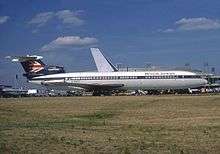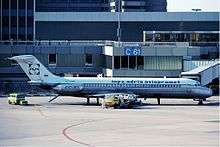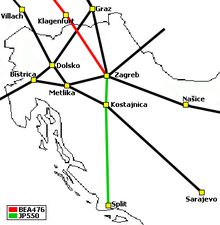1976 Zagreb mid-air collision
| Accident summary | |
|---|---|
| Date | 10 September 1976 |
| Summary | Mid-air collision caused by ATC error |
| Site |
Near Vrbovec, Croatia, Yugoslavia 45°53′33″N 16°18′38″E / 45.89250°N 16.31056°ECoordinates: 45°53′33″N 16°18′38″E / 45.89250°N 16.31056°E |
| Total fatalities | 176 (all) |
| Total survivors | 0 |
| First aircraft | |
 G-AWZT, the aircraft involved, seen at Charles de Gaulle Airport approximately 3 months before the accident | |
| Type | Hawker Siddeley Trident 3B |
| Operator | British Airways |
| Registration | G-AWZT[1] |
| Flight origin |
London Heathrow Airport London, United Kingdom |
| Destination |
Yeşilköy Int'l Airport Istanbul, Turkey |
| Passengers | 54 |
| Crew | 9 |
| Fatalities | 63 (all) |
| Survivors | 0 |
| Second aircraft | |
 An Inex-Adria Douglas DC-9 similar to the aircraft involved | |
| Type | Douglas DC-9-32 |
| Operator | Inex-Adria Airways |
| Registration | YU-AJR |
| Flight origin |
Split Airport Split, Yugoslavia |
| Destination |
Cologne Bonn Airport Cologne, West Germany |
| Passengers | 108 |
| Crew | 5 |
| Fatalities | 113 (all) |
| Survivors | 0 |

On 10 September 1976, British Airways Flight 476, a Hawker Siddeley Trident en route from London to Istanbul, collided mid-air near Zagreb, Yugoslavia (now Croatia), with Inex-Adria Aviopromet Flight 550, a Douglas DC-9 en route from Split, Yugoslavia, to Cologne, West Germany. The collision was the result of a procedural error on the part of Zagreb air traffic controllers.
All 176 people aboard both flights were killed,[2][3] making it, at the time, the world's deadliest mid-air collision.[4] It was, and remains, the only fatal accident to befall an aircraft operated by British Airways[5] (not counting BA's predecessors), as well as the deadliest aviation accident in Croatia.[6]
Flights
British Airways Flight 476 departed London Heathrow Airport for Istanbul Atatürk Airport at 08:32 UTC as flight BA476, with 54 passengers on board and a crew of 9.[7] At the controls of the Trident 3B was an experienced captain, Dennis Tann (born 1932), who by the time of the accident had accumulated 10,781 flying hours. He was assisted by first officer Brian Helm and acting first officer Martin Flint.[8]
Inex-Adria Flight 550 departed Split Airport at 09:48 UTC bound for Cologne Bonn Airport as flight JP550. It carried 108 passengers, mostly German holiday-makers returning home at the end of a holiday on the Dalmatian coast, and a crew of 5.[9] At the controls sat captain Jože Krumpak (born 1925), an experienced pilot with 10,157 flying hours, and first officer Dušan Ivanuš.[6][10] Inex-Adria was a charter airline based in Slovenia, the northernmost of the constituent republics making up the federation of Yugoslavia.
Both flights proceeded uneventfully until they approached the Zagreb VOR.
Air traffic control
In the mid-1970s, the Zagreb air traffic control region was one of the busiest in Europe despite being seriously undermanned and poorly equipped.[11] The Zagreb VOR was a reporting point for a number of congested airways between northern Europe and southeastern Europe, the Middle East, and beyond. The airspace was divided into three sectors by altitude: the lower sector below 25,000 feet, the middle sector from 25,000 to 31,000 feet, and the upper sector above 31,000 feet.[12]
Accident
On entering Yugoslav airspace from Austria, BA476 established radio contact with the Zagreb ACC upper-sector controller Gradimir Tasić at 10:04:12 UTC, informing him that they were at flight level 330 and expected to reach the Zagreb VOR at 10:14. The controller responded by instructing them to select transponder code 2312, and to call again on reaching the VOR:[7]
| 10:04:12 | BA476 | Zagreb, Bealine 476, good morning. |
| Zagreb Upp | Bealine 476, good morning, go ahead. | |
| 10:04:19 | BA476 | Er, 476, is Klagenfurt at 02, 330 and estimating Zagreb at One Four. |
| 10:04:27 | Zagreb Upp | Bealine 476, roger, call me passing Zagreb, flight level 330, Squawk Alpha 2312. |
| 10:04:40 | BA476 | 2312 is coming. |
This was the last communication with the Trident aircraft before the accident.[7]
At around the same time, JP550 contacted middle-sector controller Bojan Erjavec asking for a higher flight level; the aircraft was at flight level 260, or 26,000 feet. FL280 and FL310 were unavailable, so Erjavec informed JP550 of the situation and offered FL350, which the pilots accepted. To get clearance for a higher level, it was necessary to obtain the permission of the upper-sector controller. Erjavec waved his hand to get Tasić's attention, but Tasić (who was working the upper sector on his own, as co-worker Mladen Hochberger had gone to search for Nenad Tepeš, Tasić's replacement who was running late) was far too busy to be interrupted. Middle sector controller Gradimir Pelin was then instructed to co-ordinate the climbout for the DC-9 with Tasić.
According to Pelin, he walked to the upper sector console holding JP550's flight progress strip. He asked Tasić if the DC-9 could climb to FL350. Tasić took the strip from Pelin and looked at it, then asked where the aircraft was at the moment. Pelin then pointed to a blip on the screen approaching Kostajnica. Tasić's response was 'yes, it could climb'. Pelin then noticed an aircraft on the screen coming from the direction of Metlika and asked Tasić about it, who said 'wait until they cross'. Pelin referred to the middle-sector screen to make sure that he had identified the DC-9 positively on the upper-sector screen. He then returned to Tasić and they both watched the targets pass each other, at which point Tasić authorised JP550 to climb. Pelin then called out to Erjavec and said 'yes, climb it'. Upon Erjavec receiving the OK from Pelin, he instructed the DC-9 to climb to FL350. That was at 10:07:40.

At 10:12:03, JP550 called the Zagreb middle-sector controller to inform them that the aircraft was out of flight level 310. The last instructions given by Erjavec to JP550 were to call the upper-sector controller on 134.45 MHz and to stop squawking the assigned squawk code. By instructing JP550 to squawk Standby, Erjavec simply released a code allocated for the middle sector. The data tag for the DC-9 would now disappear from his screen and the aircraft would become merely a point among many others. If everything about this handover had been normal, the DC-9 would have been given a new code on initial contact with the upper sector controller and would have been positively identified on the upper sector screen with its flight number and altitude readout. But this had not been a normal handover because of the ill-handled co-ordination for the climb. Also, Tasić was busy with other traffic and JP550 did not immediately contact the upper-sector controller. This could have been because the frequency was busy, but the pilots might also have delayed the call for some unknown reason.
By the time JP550 contacted the upper-sector controller at 10:14:04 it had reached the Zagreb VOR and was already climbing through flight level 325. The controller immediately asked for confirmation of the aircraft's level:[13]
| 10:14:04 | JP550 | Dobar dan ["Good day"] Zagreb, Adria 550. |
| 10:14:07 | Zagreb Upp | Adria 550, Zagreb, dobar dan, go ahead. |
| 10:14:10 | JP550 | 325 crossing Zagreb at One Four. |
| 10:14:14 | Zagreb Upp | What is your present level? |
| 10:14:17 | JP550 | 327. |
Realising the imminent danger of collision, Tasić instructed the JP550 to stop climbing. In doing so, he reverted to his native Serbo-Croatian language, contrary to the regulations.[14] This meant that the British Airways plane, even if they overheard this conversation, would have very little chance of understanding their own imminent danger. The controller's last-ditch attempt to avert catastrophe turned what would have been a near miss into the collision he was trying to prevent. For, by the time JP550 had levelled off it was at flight level 330, exactly the same level as BA476:[13]
| 10:14:22 | Zagreb Upp | [stammering] ... e... zadržite se na toj visini i javite prolazak Zagreba ["uh... hold yourself at your height and report passing Zagreb"]. |
| 10:14:27 | JP550 | Kojoj visini? ["What height?"] |
| 10:14:29 | Zagreb Upp | Na kojoj ste sada u penjanju jer... e... imate avion pred vama na... [not coherent] 335 sa leva na desno. ["The height you are climbing through because... uh... you have an aircraft in front of you at... [not coherent] 335 from left to right."] |
| 10:14:38 | JP550 | OK, ostajemo točno 330. ["OK, we'll remain precisely at 330."] |
The mid-air collision occurred at 10:14:41.[7] Half a minute later, Tasić attempted to call BA476 and instruct it to report passing the next waypoint at Našice, but was answered by a different flight:
| 10:15:06 | Zagreb Upp | Bealine 476, Zagreb... report passing Nasice. |
| 10:15:12 | BE778 | Beatours 778, were you calling...? |
| 10:15:14 | Zagreb Upp | Negative. |
Tasić continued to call BA476 and JP550, ignoring calls from other aircraft, but to no avail:
| 10:15:50 | Zagreb Upp | Adria 550, Zagreb... |
| 10:16:00 | Zagreb Upp | Adria 550, Zagreb... |
| 10:16:14 | Zagreb Upp | Adria 550, Zagreb... |
| 10:16:32 | Zagreb Upp | Adria 550, Zagreb... |
| 10:16:42 | Zagreb Upp | Adria 550, Zagreb... |
| 10:16:50 | Zagreb Upp | Bealine 476, Zagreb... |
| 10:16:58 | Zagreb Upp | Bealine 476, Zagreb... |
Meanwhile, a Lufthansa Boeing 737 was travelling eastbound on UB5 at flight level 290 towards Zagreb, only 15 miles behind the Trident. The co-pilot saw the collision as a flash of lightning and afterwards, out of a ball of smoke, two aircraft falling towards the ground. The Lufthansa captain, Josef Kröse, reported the sighting to Erjavec, the middle-sector controller.[15]
| 10:15:40 | Capt Kröse R/T | ....e Zagreb! It is possible we have a mid-air collision in sight. We have two aircraft going down, well, almost below our position now. |
This was spoken in such an agitated voice that Erjavec was unable to understand what was being said. (Later, on hearing the recording of this call, Captain Kröse had difficulty in understanding his own words). The Lufthansa captain had to repeat his message several times.
| 10:18:12 | Capt Kröse R/T | It is possible that the other aircraft ahead of us had a mid-air collision....er...just overhead Zagreb. We had two aircraft going down with a rapid rate of descent...and there was also smoke coming out. |
When the implications of what was being said dawned on Erjavec he glanced across to the upper-sector controller. At his station sat a stunned Tasić, white-faced with shock. Slowly he lifted the headset from his ears and placed it on the console in front of him.
The two aircraft had collided over the town of Vrbovec, northeast of Zagreb, the last five metres of the DC-9's left wing cutting through the Trident's cockpit section and forward passenger compartment.[9][16] The explosive decompression caused the forward part of the Trident's fuselage to disintegrate; the Trident fell, landing on its tail and sliding a short distance before its remains came to rest. The DC-9, now without over one-third of its left wing, went into an immediate nose-dive and slammed into the ground right-wing first. In the end, everyone aboard both flights was killed.
A police officer who was one of the first to arrive at the scene reported that a baby on the ground was "still giving feeble signs of life near the [British] plane, but even if the ambulances had arrived before me, it would have been too late to save it."[4]
Trial
By noon that day, all controllers were in custody for interrogation. Later, all were released except Tasić, who remained in custody until the trial.
The trial opened on 11 April 1977 in Zagreb District Court. All the controllers were indicted under the Penal Code of Yugoslavia, Articles 271-72 as "persons who by endangering railway, sea or air traffic, threaten the lives of persons or property".
Tasić was the only one to be found guilty; he was sentenced to seven years' imprisonment. After a petition by air traffic controllers, it was determined that Tasić had been used as a scapegoat, and he was released on 29 November 1978. He had served nearly two years and three months in prison.
References
- ↑ "GINFO Database". Civil Aviation Authority.
- ↑ AAIB, Aircraft Accident Report 9/82, p. 8
- ↑ AAIB, Aircraft Accident Report 5/77, pp. 5-6
- 1 2 "DISASTERS: Look Up in Horror". TIME. 20 September 1976. Retrieved 19 June 2011.
- ↑ A passenger from British Airways Flight 149 who was being held hostage by Iraqi forces in 1990 was later killed by the Iraqis.
- 1 2 "Tajna leta JP550". Jutarnji list (in Croatian). 9 September 2006. Retrieved 19 June 2011.
- 1 2 3 4 AAIB, Aircraft Accident Report 5/77, p. 1
- ↑ AAIB, Aircraft Accident Report 5/77, pp. 6–8
- 1 2 AAIB, Aircraft Accident Report 5/77, p. 2
- ↑ AAIB, Aircraft Accident Report 5/77, pp. 10–11
- ↑ Weston and Hurst, Zagreb One Four, p. 26
- ↑ AAIB, Aircraft Accident Report 5/77, pp. 27–29
- 1 2 AAIB, Aircraft Accident Report 5/77, p. 4
- ↑ AAIB, Aircraft Accident Report 5/77, p. 30
- ↑ Stewart, Stanley (1994). Air disasters. Enderby: The Promotional Reprint Company. p. 142. ISBN 1-85648-182-4.
- ↑ AAIB, Aircraft Accident Report 5/77, p. 34
Cited texts
- AAIB (25 December 1976). "British Airways Trident G-AWZT, Inex-Adria DC-9 YU-AJR: Report on the collision in the Zagreb area, Yugoslavia, on 10 September 1976 (Reprint of the report produced by The Yugoslav Federal Civil Aviation Administration Aircraft Accident Investigation Commission)" (PDF). Aircraft Accident Report (5/77). ISBN 0-11-511809-8. Retrieved 27 July 2011.
- AAIB. "British Airways Trident G-AWZT, Inex-Adria DC-9 YU-AJR: Report on the collision in the Zagreb area, Yugoslavia, on 10 September 1976 (Reprint of the report produced by The Yugoslav Federal Committee for Transportation and Communications – Second Commission of Inquiry with United Kingdom Addendum)" (PDF). Aircraft Accident Report (9/82). Retrieved 27 July 2011.
- Weston, Richard; Hurst, Ronald (1982). Zagreb One Four: Cleared to Collide?. HarperCollins. ISBN 0-246-11185-2.
External links
| Wikimedia Commons has media related to 1976 Zagreb mid-air collision. |
- Final accident report 9/82 (Archive) – Yugoslav Federal Committee for Transportation and Communications Second Commission of Inquiry, Published by the Accidents Investigation Branch, Department of Trade
- Accident report 5/77 (Archive) Yugoslav Federal Civil Aviation Administration Aircraft Accident Investigation Commission. Published by the Accidents Investigation Branch.
- AirDisaster.com report on Zagreb collision
- Accident description for British Airways Flight 476 at the Aviation Safety Network
- Accident description for Inex-Adria Aviopromet Flight 550 at the Aviation Safety Network
- Pre-collision photos of Trident G-AWZT taken from Airliners.net
- Pre-collision photo of DC-9 YU-AJR taken from Airliners.net
- "Još sanjam kofere kako padaju s neba" [I still dream suitcases falling from the sky]. Jutarnji list (in Croatian). 30 August 2008. Retrieved 19 June 2011.